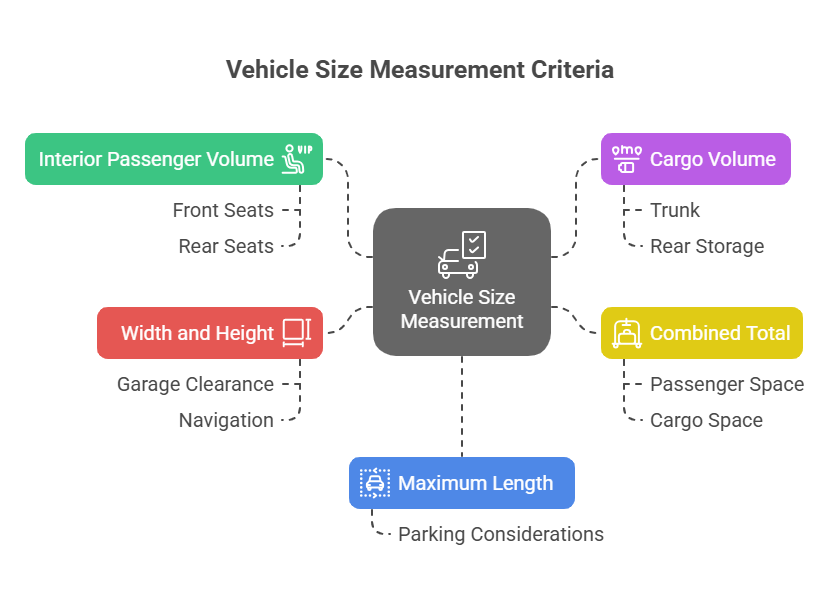:format(webp)/vulcan.abetter.bid%2Fwp-content%2Fuploads%2F2025%2F06%2Fsedan-vs-suv.png)
What Is a Midsize Car? Compare Standard vs Midsize Cars Easily
Midsize cars don’t lose their popularity in the automotive industry. They offer the perfect balance between economy and interior space. Despite SUV popularity, mid-size vehicles continue attracting car buyers. The best midsize cars represent the most popular category for drivers who need reliable transportation for both city commuting and highway travel.
Definition of a Midsize Car
The category of midsize cars is the intermediate class. It won’t be difficult to identify such an automobile. 190-195 inches is the typical length of such vehicles. Their average volume is 120 cubic feet of combined passenger and cargo space. In general, carmakers strive to produce fuel-efficient designs to maintain a comfortable ride.
Key characteristics of midsize cars include:
- Interior volume between 110-120 cubic feet.
- Length ranging from 190-195 inches.
- Seating capacity for up to five people.
- Balance of fuel economy and passenger space.
- Price point between compact and full-size cars.
How Rental Car Companies Define “Midsize” Vehicles
Rental companies classify midsize cars based on capacity and volume rather than strict dimensional measurements. Most rental agencies use the Honda Accord as the benchmark for their mid-size category. However, actual vehicles may vary by location and availability.
| Rental Category | Typical Models | Passenger Capacity | Cargo Volume |
| Midsize Car | Honda Accord, Toyota Camry | 5 | 15-16 cubic feet |
| Compact Car | Nissan Sentra, Hyundai Elantra | 5 | 12-14 cubic feet |
| Full-Size Car | Chevrolet Impala, Toyota Avalon | 5 | 16-18 cubic feet |
How Vehicle Size Is Measured

The vehicle size is measured using specific criteria established by the EPA; volume determines the classification. Mid-size cars require a minimum of 110 cubic feet of total interior space.
- Interior passenger volume – measured in cubic feet from front seats to rear.
- Cargo volume – trunk or rear storage area capacity in cubic feet.
- Combined total – sum of passenger and cargo measurements.
- Maximum length – overall vehicle length for parking considerations.
- Width and height – for garage clearance and navigation.
According to A Better Bid listings, 92% of midsize cars sold last year fit within these EPA parameters, confirming the category’s consistency across brands.
Did You Know? Many car buyers search midsize vehicles by length and trunk capacity to ensure parking fit in cities like NYC or SF.
Pros and Cons of Buying Midsize Cars
Planning to make an informed purchase decision? Grasping the benefits and drawbacks of midsize automobiles.
Advantages
The best midsize cars excel in multiple areas. These vehicles strike an optimal balance between volume, economy, and affordability. Due to rising fuel costs, the excellent fuel economy of modern mid-size models becomes increasingly valuable. The best midsize cars are particularly well-suited for city driving conditions.
Benefits of choosing a midsize car:
- Superior fuel economy compared to full-size cars.
- Adequate volume for four to five people comfortably.
- Better maneuverability in city driving and tight spaces.
- Lower insurance costs than larger cars.
- Strong resale value in the used car market.
- Ability to haul sports gear and other large items when needed.
Disadvantages
Despite their popularity, mid-size cars have limitations. Families with growing children may find the volume insufficient. Additionally, those transitioning from sports car ownership might miss the performance characteristics of sportier, subcompact cars.
Potential drawbacks include:
- Limited volume compared to SUVs and full-size cars.
- Less leg room than larger sedans.
- Reduced towing capacity for recreational vehicles.
- May feel underpowered when fully loaded with passengers.
- Less commanding road presence than larger vehicles.
Midsize vs Compact vs Full-Size Cars
Compact cars prioritize economy and affordability. Full-size cars emphasize space and comfort. Mid-size cars occupy the sweet spot. Specifically, they offer reasonable fuel economy while providing more space than compact vehicles. The best midsize cars consistently outperform compact automobiles in comfort. Thus, they’re ideal for city parking and suburban driving alike.
| Aspect | Compact Car | Midsize Car | Full-Size Car |
| Full Length | 175-185 inches | 190-195 inches | 200+ inches |
| Interior Volume | 85-99 cubic feet | 110-120 cubic feet | 120+ cubic feet |
| Fuel Economy (City) | 28-35 mpg | 24-32 mpg | 20-28 mpg |
Mid-size cars account for approximately 15% of total vehicle sales. Thus, they form a significant segment despite SUV growth.
Midsize Cars vs Midsize SUVs and Crossovers

The choice is often based on personal preferences. Specific priorities and driving habits determine drivers’ intentions. A higher seating position and more volume are typical SUVs’ features. Midsize cars deliver superior fuel economy and easier parking in urban environments. When buying a car from auction, both categories maintain strong resale values. However, cars typically depreciate more predictably. For city dwellers, midsize cars remain the preferred choice over SUVs.
| Aspect | Midsize Car | Midsize SUV |
| Economy | 25-35 mpg combined | 22-28 mpg combined |
| Volume | 14-16 cubic feet | 25-35 cubic feet |
| Ground Clearance | 5-6 inches | 7-9 inches |
| Standard All-Wheel Drive | Rare | Common |
Insurance Costs for Medium Size Cars vs Other Segments
Mid-size cars typically offer lower insurance premiums than full-size vehicles or SUVs. Therefore, these automobiles are cost-effective choices for families. Favorable insurance rates are achieved by the combination of safety ratings, repair costs, and theft statistics. Smart buyers often use a VIN decoder to verify the vehicle’s history. City drivers particularly benefit from lower insurance rates. In urban environments, the risk profile of midsize cars is reduced.
Popular Midsize Cars in 2025

The current mid-size market offers small imported cars with advanced technology and improved efficiency. The best midsize cars in today’s market appeal to both city and village shoppers.
Resale Value: Best and Worst Models After 3 Years
Resale value varies significantly among midsize cars. Some new models retain over 60% of their original value after three years. Japanese and South Korean manufacturers typically lead in reliability and resale strength. The turning point for many buyers comes when comparing total ownership costs rather than just purchase price. Additionally, if the car had too many owners, it would be another reason for reducing its value.
| Model | 3-Year Resale Value | Reliability Rating | Fuel Economy (Combined) |
| Honda Accord | 58% | Excellent | 32 mpg |
| Toyota Camry | 56% | Excellent | 31 mpg |
| Hyundai Sonata | 45% | Good | 33 mpg |
| Nissan Altima | 42% | Average | 29 mpg |
| Chevrolet Malibu | 38% | Below Average | 30 mpg |
Rare Midsize Sedans with AWD
Most midsize cars use front-wheel drive. The goal is to maximize fuel efficiency and volume. Thus, all-wheel drive is relatively uncommon in this segment. However, several manufacturers offer AWD options. They are suitable for drivers in harsh weather climates or those prioritizing traction over fuel efficiency.
Current midsize sedans with standard all-wheel drive or AWD options:
- Subaru Legacy – standard AWD across all trim levels.
- Nissan Altima – available AWD on select trims.
- Toyota Camry – AWD available on specific automobiles.
- Acura TLX – standard AWD on higher trims.
A Better Bid research indicates that only 12% of midsize car buyers opt for all-wheel drive, primarily in northern climates.
Midsize Car Interior Layouts
Modern midsize cars prioritize passenger comfort with improved volume utilization. The first half of the cabin focuses on driver and front passenger comfort. Rear seating accommodates three adults reasonably well. These features help ensure a comfortable ride.
Summary
The midsize car segment is constantly developing. These automobiles are gaining popularity and offer excellent characteristics. Drivers value fuel economy, adequate volume, and reasonable pricing. You may be a first-time buyer or considering a change from other size categories. Anyway, midsize cars provide versatile transportation solutions for modern life.
![]() FAQ
FAQ
Show more
What Is the Cheapest Midsize Car?
$25,000 is the starting price of midsize cars. Several manufacturers offer competitive pricing. To save your budget, consider comparing total ownership costs rather than just purchase price.
Most affordable midsize cars include:
Hyundai Sonata – starting around $25,000.
Kia K5 – competitive pricing with strong warranty.
Nissan Altima – often features manufacturer incentives.
Chevrolet Malibu – frequently discounted by dealers.
What Is the Difference Between Economy Cars and Midsize Cars?
Fuel-efficient cars prioritize low purchase prices over volume and comfort. The choice depends on individual priorities regarding volume versus economy.
Are Midsize Sedans Good for Family Road Trips?
Midsize sedans can work well for family road trips. Most cars comfortably seat four adults.
Family road trip considerations:
– Comfortable seating for up to five people on longer drives.
– Sufficient cargo space for luggage and travel essentials.
– Good fuel economy reduces travel costs.
– Reliable performance for highway driving.
– Advanced safety features in most cars.
Can a Midsize Car Be a Hatchback or Wagon?
As a rule, mid-size cars are manufactured as sedans. However, it’s not always the case. Some manufacturers offer hatchback or wagon variants. These body styles provide more cargo flexibility. They also preserve the fuel-efficient characteristics of traditional midsize cars.
Do Midsize Vehicles Qualify for Tax Credits?
Tax credit eligibility depends on the powertrain type. Electric and hybrid cars potentially qualify, regardless of their size category.
Potential tax benefits include:
Federal EV tax credits up to $7,500 for qualifying electric cars.
State and local incentives varying by location.
Hybrid vehicles may qualify for reduced credits.
Businesses use deductions available for qualifying buyers.
Check current IRS guidelines for specific model eligibility.
Recommended Articles
:format(webp)/vulcan.abetter.bid%2Fwp-content%2Fuploads%2F2023%2F03%2Frawkkim-UsWvRFTssRs-unsplash.jpg)
How to Buy Cars at Auction: Buying Guide & Tips
:format(webp)/vulcan.abetter.bid%2Fwp-content%2Fuploads%2F2024%2F02%2Fpawan-kumar-iWc4Tz6DXQU-unsplash.jpg)

:format(webp)/vulcan.abetter.bid%2Fwp-content%2Fuploads%2F2022%2F10%2F2022-10-05-11.30.40-150x150.jpg)
 FAQ
FAQ :format(webp)/vulcan.abetter.bid%2Fwp-content%2Fuploads%2F2024%2F03%2Faustin-lowman-SpSVyLVB_5g-unsplash.jpg)
:format(webp)/vulcan.abetter.bid%2Fwp-content%2Fuploads%2F2025%2F10%2Fcopart-vs-a-better-bid.png)
:format(webp)/vulcan.abetter.bid%2Fwp-content%2Fuploads%2F2025%2F10%2Fcopart-vs-iaai-1.png)
:format(webp)/vulcan.abetter.bid%2Fwp-content%2Fuploads%2F2025%2F09%2Fvasile-valcan-1HqixV1agUw-unsplash.jpg)

